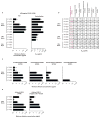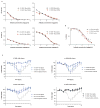Both Neutralizing and Non-Neutralizing Human H7N9 Influenza Vaccine-Induced Monoclonal Antibodies Confer Protection
- PMID: 27281570
- PMCID: PMC4901526
- DOI: 10.1016/j.chom.2016.05.014
Both Neutralizing and Non-Neutralizing Human H7N9 Influenza Vaccine-Induced Monoclonal Antibodies Confer Protection
Abstract
Pathogenic H7N9 avian influenza viruses continue to represent a public health concern, and several candidate vaccines are currently being developed. It is vital to assess if protective antibodies are induced following vaccination and to characterize the diversity of epitopes targeted. Here we characterized the binding and functional properties of twelve H7-reactive human antibodies induced by a candidate A/Anhui/1/2013 (H7N9) vaccine. Both neutralizing and non-neutralizing antibodies protected mice in vivo during passive transfer challenge experiments. Mapping the H7 hemagglutinin antigenic sites by generating escape mutant variants against the neutralizing antibodies identified unique epitopes on the head and stalk domains. Further, the broadly cross-reactive non-neutralizing antibodies generated in this study were protective through Fc-mediated effector cell recruitment. These findings reveal important properties of vaccine-induced antibodies and provide a better understanding of the human monoclonal antibody response to influenza in the context of vaccines.
Copyright © 2016 Elsevier Inc. All rights reserved.
Figures






Similar articles
-
Broadly-Reactive Neutralizing and Non-neutralizing Antibodies Directed against the H7 Influenza Virus Hemagglutinin Reveal Divergent Mechanisms of Protection.PLoS Pathog. 2016 Apr 15;12(4):e1005578. doi: 10.1371/journal.ppat.1005578. eCollection 2016 Apr. PLoS Pathog. 2016. PMID: 27081859 Free PMC article.
-
L226Q Mutation on Influenza H7N9 Virus Hemagglutinin Increases Receptor-Binding Avidity and Leads to Biased Antigenicity Evaluation.J Virol. 2020 Sep 29;94(20):e00667-20. doi: 10.1128/JVI.00667-20. Print 2020 Sep 29. J Virol. 2020. PMID: 32796071 Free PMC article.
-
A cross-reactive human monoclonal antibody targets the conserved H7 antigenic site A from fifth wave H7N9-infected humans.Antiviral Res. 2019 Oct;170:104556. doi: 10.1016/j.antiviral.2019.104556. Epub 2019 Jul 9. Antiviral Res. 2019. PMID: 31299269
-
Implications of broadly neutralizing antibodies in the development of a universal influenza vaccine.Curr Opin Virol. 2016 Apr;17:110-115. doi: 10.1016/j.coviro.2016.03.002. Epub 2016 Mar 28. Curr Opin Virol. 2016. PMID: 27031684 Free PMC article. Review.
-
Passive immunization for influenza through antibody therapies, a review of the pipeline, challenges and potential applications.Vaccine. 2016 Oct 26;34(45):5442-5448. doi: 10.1016/j.vaccine.2016.08.057. Epub 2016 Sep 9. Vaccine. 2016. PMID: 27622299 Free PMC article. Review.
Cited by
-
A Candidate Therapeutic Monoclonal Antibody Inhibits Both HRSV and HMPV Replication in Mice.Biomedicines. 2022 Oct 8;10(10):2516. doi: 10.3390/biomedicines10102516. Biomedicines. 2022. PMID: 36289776 Free PMC article.
-
One HA stalk topping multiple heads as a novel influenza vaccine.Emerg Microbes Infect. 2024 Dec;13(1):2290838. doi: 10.1080/22221751.2023.2290838. Epub 2024 Jan 22. Emerg Microbes Infect. 2024. PMID: 38044872 Free PMC article.
-
Monoclonal Antibodies with Neutralizing Activity and Fc-Effector Functions against the Machupo Virus Glycoprotein.J Virol. 2020 Feb 14;94(5):e01741-19. doi: 10.1128/JVI.01741-19. Print 2020 Feb 14. J Virol. 2020. PMID: 31801871 Free PMC article.
-
A Complex Dance: Measuring the Multidimensional Worlds of Influenza Virus Evolution and Anti-Influenza Immune Responses.Pathogens. 2019 Nov 15;8(4):238. doi: 10.3390/pathogens8040238. Pathogens. 2019. PMID: 31731815 Free PMC article. Review.
-
Exploring the global immune landscape of peripheral blood mononuclear cells in H5N6-infected patient with single-cell transcriptomics.BMC Med Genomics. 2023 Oct 18;16(1):249. doi: 10.1186/s12920-023-01693-7. BMC Med Genomics. 2023. PMID: 37853397 Free PMC article.
References
-
- Baudino L, Shinohara Y, Nimmerjahn F, Furukawa J, Nakata M, Martinez-Soria E, Petry F, Ravetch JV, Nishimura S, Izui S. Crucial role of aspartic acid at position 265 in the CH2 domain for murine IgG2a and IgG2b Fc-associated effector functions. J Immunol. 2008;181:6664–6669. - PubMed
-
- Chen H, Yuan H, Gao R, Zhang J, Wang D, Xiong Y, Fan G, Yang F, Li X, Zhou J, et al. Clinical and epidemiological characteristics of a fatal case of avian influenza A H10N8 virus infection: a descriptive study. Lancet. 2014a;383:714–721. - PubMed
MeSH terms
Substances
Grants and funding
LinkOut - more resources
Full Text Sources
Other Literature Sources
Medical

